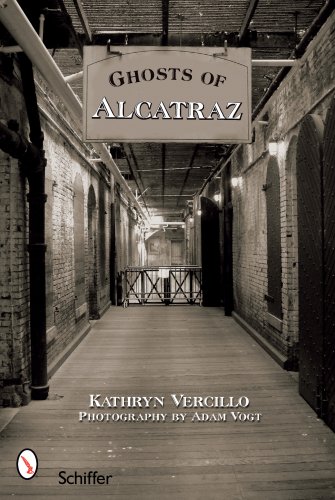|
Kathryn Vercillo, Ghosts of Alcatraz (Schiffer, 2008) The prison at Alcatraz Island has to be one of the spookiest places in the United States. The echoes of desperation and misery permeate its walls, the ghosts of which it is impossible to ignore. Its storied history begins with the Native Americans who avoided the island, believing it was the "dwelling [place] of evil spirits." Its uses by the United States government include a Civil War military prison in the 1800s and a federal penitentiary beginning in 1934. It is commonly known for its torturous treatment of its prisoners, punishment that included "The Hole," isolation cells that were known to have driven more than one man mad, "dungeon cells" where prisoners were shackled to the walls, and "the silent treatment," during which prisoners were not allowed to communicate at all. Most of these were eventually abandoned after being declared "cruel and unusual punishment," but their use would have been conducive to creating an environment that would not easily have been forgotten by those who were incarcerated here.
I had great hopes for this book when I was presented early on with a detailed timeline of Alcatraz Island's history. It is obvious Vercillo dedicated a lot of time to researching the information she presents here (extensive bibliography included), and she gives us a solid understanding of the events that took place here over time. But what we get as a result is a compilation of books that have already been written, rather than having the author draw any new conclusions of her own. She has made the trip to Alcatraz Prison, and she makes statements such as "When you hear ... the low strum of Al Capone's guitar, or sense the unseemly chill emanating from the cell of Robert 'Birdman' Stroud ...." Is the author speaking of her own experiences, or is this pure speculation drawn from other accounts? It is hard to tell. Based on the rest of the book, I vote for the latter. Vercillo speaks mainly in generalizations, such as "It is said that...," and "Many believe that...." She does an excellent job of setting the mood and bringing to life the ominous surroundings of a trip to the island. But I kept expecting to get to the meat and potatoes, and they just never came. Ultimately, the book just doesn't deliver anything new. The author does an exceptional job in presenting us with known history and rumored hauntings, but has no ghostly experiences of her own to document, nor has she interviewed any witnesses. In fairness, I must mention that Adam Vogt's photography is very successful in delivering many eerie pictures from both inside and outside the prison, but again, nothing new. No new orbs captured on film or the like. Also, there is a glossary at the end of the book of paranormal terms with which to familiarize yourself before your trip to Alcatraz, none of which were encountered here. There is also much time devoted to another section at the end detailing equipment used in paranormal investigations, again, none of which were used here. This equipment section is published by the Chester County Paranormal Research Society in Pennsylvania, which had absolutely nothing to do with this book. That confuses me a bit. Is this just information for information's sake? It's interesting, but was it appropriate to include it here? Is the author preparing us to take part in a professional ghost hunt? Maybe. I'm not sure. To borrow a term from the author, "it is often said" that spirits, rather than passing on to where they belong, remain behind to deal with unfinished business, trapped and unable to move forward and away from the location of their suffering, or so the thinking goes, creating what the living call "ghosts." The "worst of the worst" were incarcerated here, such as George "Machine Gun" Kelly, Abie "Butcher" Maldowitz and Al Capone. Did they deserve such extreme punishment, punishment that prisoners called "hell on earth?" That is a question you must answer for yourself. Either way, the suffering finally ended when the penitentiary closed its doors in 1963. Today, happy, interested tourists explore Alcatraz with a sense of curiosity and anticipation that belies its most recent incarnation as the most notorious prison in the United States. Its history must be approached with respect. So, could there be ghosts at Alcatraz? My guess would be yes, but the jury's still out. 
|
 Rambles.NET book review by Lee Lukaszewicz 14 July 2012 Agree? Disagree? Send us your opinions!  



 |

